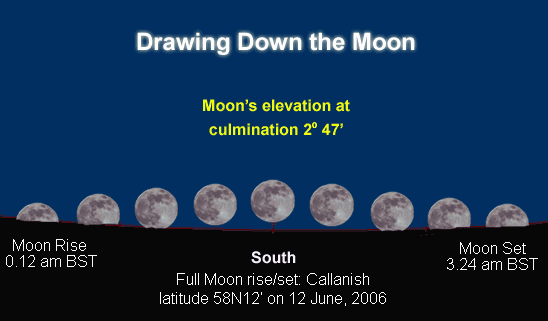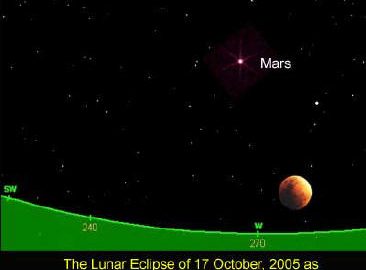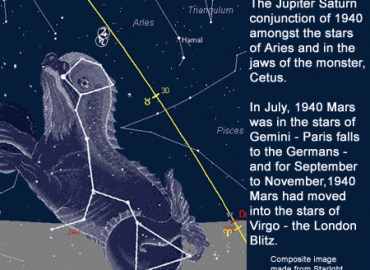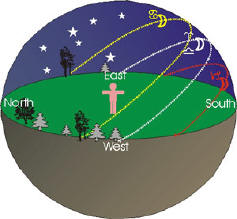Bernadette Brady
March 2006
From our solar calendar perspective we tend to see the lunar calendar as irregular and unreliable. In fact it is extremely regular, not by the seasons but rather by the months.
In a lunar calendar, the Moon’s phase will always be at the same day of the calendar month with the new moon always occurring on the 1st of the month, the full moon on the 14th, and so on. Additionally, the elevation of the moon’s arc across the evening sky as it travels from east to west will be the same for any specific month. Thus if we lived by a lunar calendar and March was the name of one of the lunar months then I would expect that 7th March every year would have a first quarter moon – seven days after the new moon – and that this moon would rise to an elevation during the night which would be different from all the other months but the same for every March from one year to the next. So the lunar calendar drifts against the seasons but is tightly focused on the visual appearance of the moon. The Jewish and Islamic faiths still work with a lunar calendar.

Expanding this pattern, we can see that the full moons of the summer months, regardless of the hemisphere, are lower in the night sky, keeping closer to the horizon, than the full moons of the winter months which reach a greater elevation in the night sky.
Therefore the lowest full moon of the year will be at the time of the summer solstice and the highest full moon of the year will be at the time of the winter solstice.
This is a pattern, a dance the moon produces that the lunar calendar not only acknowledges but also brings into sharp focus for us.
This focus was important to the Assyrian astrologer/priest of 650 B.C.E. who noted that, when the moon god Sin was traveling through the stars of Capricorn, he would always be low in the sky. However, when Sin traveled through the stars of Cancer, he could gain great elevation, climbing to his highest position in the night sky. (It is tempting to see this as being linked to the astrological idea of rulership and detriment of the moon but that idea needs to wait for another newsletter).

Yet the position of the moon in the sky has another rhythm which mingles with its normal seasonal rhythm. There is a 18/19-year cycle where the moon will be seen to be even lower in the sky, closer to the horizon or far higher than its normal position. We do not pay any attention to this in our modern astrology but the Assyrians recorded the moon’s movement every month, including such odd positions in a particular month as these. Sometimes this was considered fortunate; at other times it was a sign of “wolves and lions ravishing the land.”
This potential of the moon to rise but keep close to the earth was also mentioned by the Greek historian, Diodorus of Sicily (80-20 BCE) in his Biblio Theca historica . About 50 B.C.E. he wrote of a circular temple on the island of Hyperborean where “ the moon appeared to be close to the Earth and that the gods visited the island every 19 years”
The island in question is a somewhere near Greenland or the upper parts of Scotland which many believe to be the circle of stones at Callanish, UK, and which appear to have strong visual links to this particular lunar cycle (Callanish shown image right). Others consider that Diodorus was been referring to Stonehenge (upper image).
By this comment, Diodorus of Sicily is suggesting that the tendency of the risen moon to stay close to the earth is a sign of the gods touching the earth or visiting the earth. The Roman poet Horace (Epode 17) also implies this when he quotes the witch Canidia who tells him that she can “Draw down the Moon”, as does Guiley (1989:107) who requotes the ancient Thessalian witch believed to control the moon who said:
If I command the moon, it will come down; and if I wish to withhold the day, the night will linger over my head; and again, if I wish to embark on the sea, I need no ship, and if I wish to fly through the air, I am free of my weight.

[Note: For those readers who own Starlight, create a chart for the 12 June, 2006 for Callanish, UK, then look at the chart as a sky map. Point south and run Starlight’s animation feature at steps of about 10 minutes at a time and you will be able to watch the full moon roll along the horizon. Then change the date to another year, say 1997, and look at the summer full moon and its movement and you will see the difference in the elevation of the moon.]
Furthermore, the ceremony or ritual of the drawing down of the moon is not lost in antiquity, for in recent times, according to Adler (1986:19), neo-pagans have revived and re-created the ceremony which, she suggests, is one of their most powerful rituals for bringing the energy of the goddess down to earth and it should be performed as near as possible to the time of the full moon. This is a time, believed within neo-paganism, where the goddess, symbolised by the moon, is reaching out and can be linked to the person performing the ceremony.
Yet without detracting from this ceremony’s magic or power, a simply piece of astronomy may well lie at the heart of this ancient ritual, for at the time of warm weather and clearer skies, the full moon does hang lower in the sky and therefore one could well be led to believe that the “witches” of Thessaly out in the woods on a summer’s night were actually “drawing down the moon”.
The Drawing Down of the Natal Moon.
As astrologers we draw down the sky and make our maps but in our horoscopes we do not ponder over the concerns of whether the Moon is being “drawn down”. However, by running a scan in Jigsaw, I noted two people in my files who were born when the moon was full and being “drawn down”.
The first example seems to reflect the very nature of those ancient Thessalian witches and it is the dancer Isadora Duncan. Born on 26th May, 1877, in San Francisco (some web sites have this date a year and a day later), she traveled to Europe in her early twenties, seeking to promote her provocative but natural dance style which totally rejected the rigid format of classical dancing. She was a dancer best known as an advocate of natural rhythm. She became an overnight sensation both in England and Europe where she began to appear in private receptions, dressed scantily and dancing in bare feet. Her life was short and tragic but through her dancing she is remembered as giving back to western culture a more natural and primal form of dance. She was born on the day of the “drawing down” of the Moon and one could easily say that she was touched by this ancient lunar rhythm.
The second example is the singer Cat Stevens, now known as Yusuf Islam. As Cat Stevens, Yusuf was a singer and song writer from the 1960s and 1970s and he sold over 40 million albums. He was born on 21st July, 1948, London, and was and indeed still is, renowned for his spiritual orientation. In the midst of a successful, high profile career in the music industry, he converted to Islam. As Cat Stevens he wrote many famous songs but the one that seems to become most significant, given the knowledge of his natal moon and its “drawn down” nature, is titled “Moonshadow”. It is not hard to consider this writer, singer and spiritual man also being touched by the light of the moon.
On a Personal Level
As an astrologer, not many charts that you will see will have their natal moon being “drawn down” to the earth but when it does, such a moon seems to fill the person with the light of another world, the light of another rhythm. So if you, or your client, were born with a full moon in Capricorn, do just have a look at the declination or celestial latitude of the moon. If the moon is south of the ecliptic, then it is being “drawn down”. For a birth in the southern hemisphere, if you find the moon in Cancer north of the ecliptic, then it is being “drawn down” to earth.
Sources:
Adler, Margot.(1986). Drawing Down the Moon. Boston, USA: Beacon Press.
Guiley, Rosemary Ellen. (1989). The Encyclopedia of Witches and Witchcraft.




